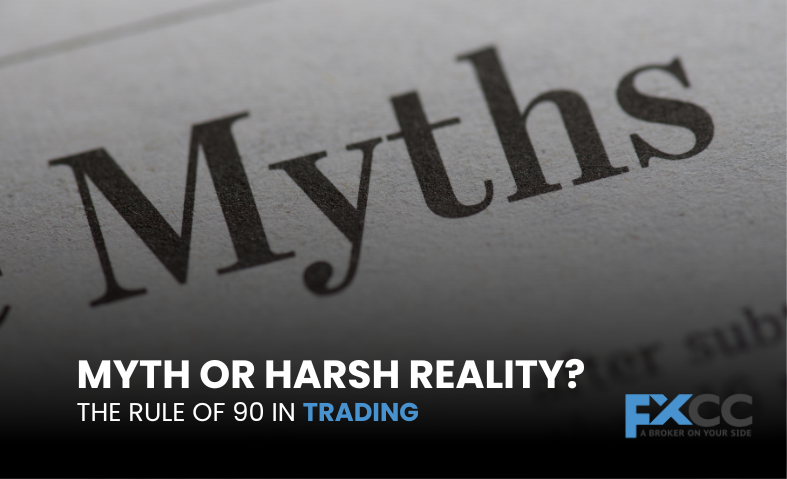Trading has always been an alluring venture for those looking to build wealth, yet it remains one of the most challenging professions to master. Among traders, a widely circulated belief exists known as the “Rule of 90.” This rule states that 90% of traders lose 90% of their money within 90 days. It’s a sobering thought, but is it a harsh reality or just a myth exaggerated by market fear?
Understanding the Rule of 90
The Rule of 90 suggests that the vast majority of new traders fail within the first three months. This implies that trading is incredibly difficult, and most people who enter the market do so without the necessary skills, knowledge, or mindset. While there is no official data confirming this exact statistic, several studies and broker reports indicate that an overwhelming number of retail traders do indeed lose money, especially early on in their trading journey.

What causes such high failure rates? Trading is often marketed as a quick and easy way to make money, but in reality, it requires patience, discipline, and a deep understanding of market dynamics. Many traders enter with unrealistic expectations, overleverage their positions, and fail to manage risk effectively.
Psychological Challenges That Lead to Losses
One of the biggest reasons why traders fail so quickly is the psychological aspect of trading. The emotional rollercoaster of wins and losses can lead to impulsive decision-making. Fear and greed drive many traders to make irrational moves—holding onto losing trades too long, cutting winning trades too short, or overtrading in an attempt to recover losses.
New traders also suffer from confirmation bias, where they seek information that supports their existing beliefs while ignoring evidence to the contrary. This often leads to overconfidence, which results in poor decision-making and, ultimately, losses.
Moreover, many traders experience FOMO (fear of missing out), which pushes them to enter trades without proper analysis. They chase the market, buying at peaks and selling at lows, which is a direct recipe for failure.
Lack of Proper Risk Management
Risk management is the backbone of successful trading, yet most new traders ignore it completely. They risk too much on a single trade, fail to use stop-loss orders, or allow emotions to dictate their risk exposure.
Without effective risk management, even a small series of losing trades can deplete a trading account. Professional traders emphasize capital preservation above all else, while beginners tend to focus solely on profit potential, leading to reckless behavior.
The use of high leverage is another common mistake. Leverage can enhance potential gains, but it also significantly increases the risk of heavy losses. Many new traders, enticed by the possibility of large returns, take on excessive leverage, which significantly increases their chances of blowing up their accounts within a short period.
Lack of Education and Strategy
Most people enter trading without proper education. They rely on social media influencers, signals, or gut feelings rather than studying technical and fundamental analysis. Trading is a skill that requires continuous learning, yet many traders approach it with a gambling mentality rather than a strategic one.
A lack of a well-defined trading plan also contributes to early failure. Successful traders operate with clear strategies, predefined risk-reward ratios, and a disciplined approach. Beginners, on the other hand, often jump from one strategy to another, looking for a “holy grail” that doesn’t exist.
Is the Rule of 90 a Myth or Reality?
While the exact 90-90-90 statistic may not be scientifically proven, there is no doubt that a majority of retail traders lose money quickly. Several broker reports suggest that around 70% to 80% of retail traders lose money, which, while slightly better than the Rule of 90 suggests, still highlights the harsh realities of trading.
However, this does not mean success is impossible. The few who do succeed understand the importance of risk management, psychology, and continuous learning. They treat trading as a business rather than a get-rich-quick scheme.
Ways to Escape the 90% Failure Rate in Trading
The key to survival in trading is education and discipline. Traders must invest time in learning technical and fundamental analysis, understanding market behavior, and developing a sound trading strategy. Risk management should be a priority, ensuring that no single trade can significantly damage their account.
Patience is crucial. Many traders fail because they expect immediate results, but successful trading requires consistency over time. Keeping a trading journal, learning from mistakes, and adapting to market conditions are essential for long-term success.
Lastly, traders must learn to control their emotions. The ability to stay disciplined and stick to a plan, regardless of wins or losses, is what separates professionals from amateurs.

The Rule of 90 serves as a warning rather than an absolute truth. While the failure rate among traders is undeniably high, it is not an unchangeable destiny. Many traders fail due to lack of knowledge, poor risk management, and emotional trading, but those who approach the market with a strategic and disciplined mindset can beat the odds.
Trading is not easy, but it is possible to succeed with the right approach. Instead of fearing the Rule of 90, traders should use it as motivation to invest in their education, develop a solid strategy, and trade with patience and discipline.


